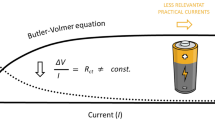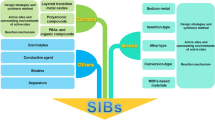Abstract
Niobium suboxide powder was pressed and sintered in vacuum into NbO electrolytic capacitor sintered anode. High voltage and constant current formation experiment was performed on NbO electrolytic capacitor anode, during which electrolyte was 0.01% H3PO4 solution, temperature was 90 °C and current was 50 mA per gram sample. Through the relationship between anode voltage and time and scanning electron microscopy(SEM) images of invalidated anode and normal forming anode, invalidation manner and mechanism of NbO electrolytic capacitor anode were discussed. The results show that, the main invalidation manner of NbO electrolytic capacitor anode is not short circuit but open circuit, which is different to that of traditional Ta electrolytic capacitor anode. The reason of invalidation is that anode oxide film whose thickness increases gradually penetrates the “connection neck’ among anode powder particles, which leads to the open circuit invalidation of anode. Compared with Ta electrolytic capacitor, NbO electrolytic capacitor has better security.
Similar content being viewed by others
References
HE Ji-lin. New development of tantalum and niobium electronic materials[J]. The Chinese Journal of Nonferrous Metals, 2004, 14(S1):291–300. (in Chinese)
LI Chun-guang, ZHONG Jing-ming, GAO Yong, et al. Niobium capacitor and its dielectric stability[J]. The Chinese Journal of Nonferrous Metals, 2003, 13(6): 1401–1406. (in Chinese)
ZHONG Hui, LI Jian, DAI Yan-yang, et al. Latest development and research on electrolytic niobium capacitor[J]. Chinese Journal of Rare Metals, 2002, 26(2): 139–142. (in Chinese)
Reichert K, Thomas O, Vieregge J. Production of niobium and tantalum powders[P]. DE 19831280,2000-01-20
Oda Y. Tantalum powder, niobium powder their manufacture, and capacitor anodes[P]. JP 2000226607, 2000-08-15.
Habecker K A, Fife J A. Wet milling with heating for manufacture of metal powders, including niobium powder for electrolytic capacitors[P]. WO 2000056486, 2000-09-28
Arinkin A V, Board B G, Gubenko E P, et al. Regularities of niobium powder purification by carbon in production of solid niobium capacitors[J]. Poroshkovaya Metallurgiya, 1997, (3–4):70–75.
Yang H K, Ryosuke O S, Hiroshi N, et al. Removal of oxygen and nitrogen from niobium by external gettering[J]. Journal of Alloys and Compounds, 1997,248:251–258
Naito K. Niobium powder, niobium sintered body, capacitor comprised of the sintered body, and method for manufacturing the capacitor [P]. WO 2000049633, 2000-08-24.
Naito K, Shimojima A. Sinter of niobium for capacitor, and method of manufacture thereof[P]. WO 2000008662, 2000-02-17
Naito K, Shimojima A. Niobium capacitor and method of manufacture thereof[P]. WO 2000036617, 2000-06-22.
Fife J A. Nitrided niobium powders and niobium electrolytic capacitors[P]. WO 9957739,1999-11-11.
Habecker K A, Fife J A. High capacitance niobium powders and electrolytic capacitor anodes [J]. WO 2000069588, 2000-11-23.
Kimmel J L, Kitchell R W, Fife J A. Methods to partially reduce a niobium metal oxide and oxygen reduced niobium oxides[P]. US 6373685 B1,2002-04-16.
Fife J A. Partial reduction of niobium pentoxide for its use as a capacitor anode[P]. US 6416730 B1,2002-07-09.
Schnitter C, Reichert K. Niobium based electrolytic capacitor anode[P]. WO 2002017338 A1,2002-02-28.
Naito K, Nagato N. Niobium powder for capacitor, sintered body thereof and capacitor using the sintered body[P]. WO 2002045107 A1,2002-06-06.
Kimmel J L, Redd R V. Refractory metal suboxice powders suitable for sintered capacitor anodes[P]. WO 2002037513 A2,2002-05-10.
SHEN Pan-wen, CHE Yun-xia, LUO Yu-ji, et al. Series of Inorganic Chemistry (Vol. 8 Ti, V, Cr) [M]. Beijing: Science Press, 1998. (in Chinese)
Author information
Authors and Affiliations
Corresponding author
Rights and permissions
About this article
Cite this article
Li, J., Yi, Dq., Wen, Jj. et al. Invalidation manner and mechanism of new type NbO electrolytic capacitor anode. J Cent. South Univ. Technol. 12 (Suppl 1), 18–22 (2005). https://doi.org/10.1007/s11771-005-0364-7
Received:
Accepted:
Published:
Issue Date:
DOI: https://doi.org/10.1007/s11771-005-0364-7




